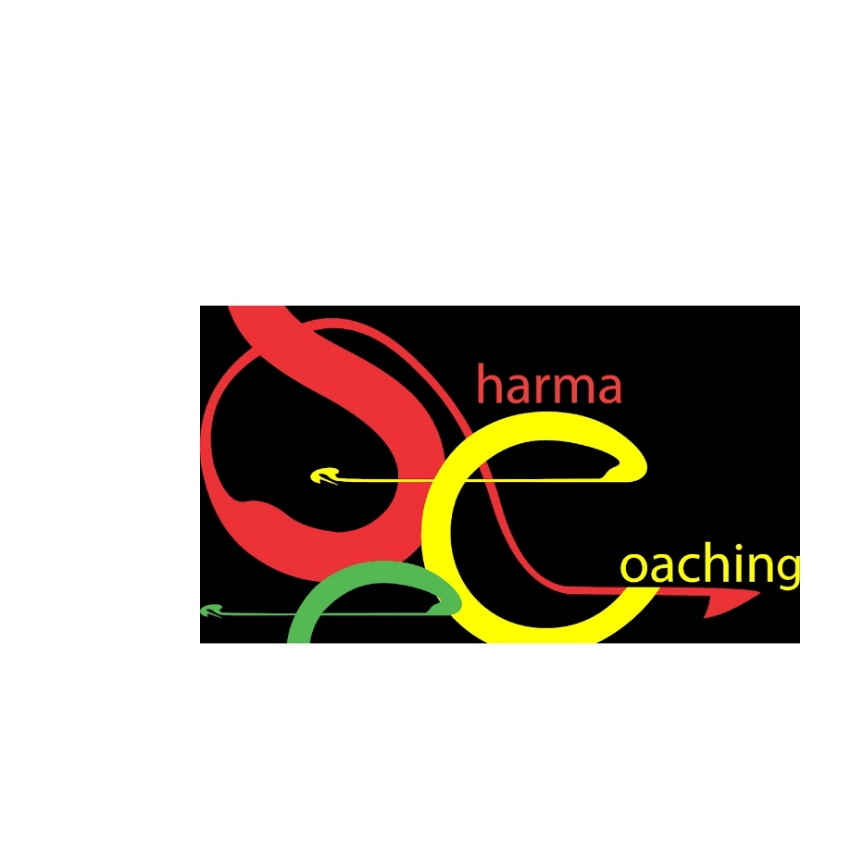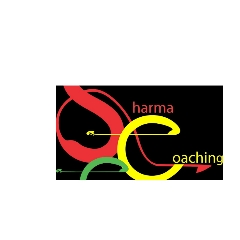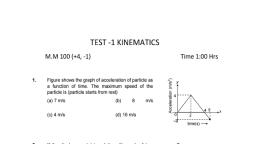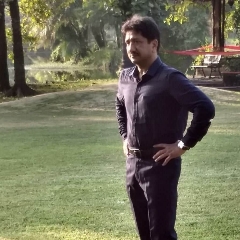Question 1 :
A car is moving on a horizontal circular road of radius 100 m with a uniform speed 10 ms<sup>-1</sup>. It suddenly accelerates at 1 ms<sup>-2</sup>. The acceleration is
Question 2 :
A train starts from station <em>A</em> with uniform acceleration <em>a</em><sub>1</sub> for some distance and then goes with uniform retardation <em>a</em><sub>2</sub> for some more distance to come to rest at station <em>B</em>. The distance between <em>A</em> and <em>B</em> is 4 km and the train takes 4 hours to complete this journey. If acceleration and retardation are in km/ hour<sup>2</sup>, then
Question 3 :
A particle is moving on a circular path of radius {tex}\frac{\text{100}}{\sqrt{\text{19}}}{/tex}m in such a way that magnitude of its velocity varies with time as <em>v</em> = 2<em>t</em><sup>2</sup> + <em>t</em>, where <em>v</em> is velocity in m/s and <em>t</em> is time in s. The acceleration of the particle at <em>t</em> = 2 s is
Question 4 :
A bullet is fired with a gun from a tower horizontally with a velocity 400 m/s. At the same time a stone is dropped from the same tower
Question 5 :
A balloon rises from rest with a constant acceleration {tex}\frac{g}{8}{/tex}. A stone is released from it when it has risen to height <em>h</em>. The time taken by the stone to reach the ground is
Question 6 :
A bullet is fired horizontally from a rifle at a distant target. Ignoring the effects of air resistance, what are the horizontal and vertical accelerations of the bullet? Horizontal vertical
Question 7 :
A boat travels from south bank to north bank of river with a maximum speed of {tex}8 \mathrm { km } / \mathrm { h } {/tex} . A river current flows from west to east with a speed of {tex}4 \mathrm { km } / \mathrm { h } {/tex} . To arrive at a point opposite to the point of start, the boat should start at an angle
Question 8 :
A stone is thrown form a cliff of height h in a given direction then the speed with which it hits ground -
Question 9 :
The acceleration of a particle, starting from rest, varies with time according to the relation <em>a</em> = <em>k</em> <em>t</em> + <em>c</em>. The velocity <em>v</em> of the particle after a time <em>t</em> will be
Question 10 :
A ball is dropped from the top of a building. The ball takes 0.5 s to pass the 3 m length of a window some distance from the top of the building. If the velocities of the ball at the top and at the bottom of the window are <em>v</em><sub><em>T</em></sub> and <em>v</em><sub><em>B</em></sub> respectively, then
Question 11 :
A boat which has a speed of 5 m/s in still water crosses the river of width 25 m in 10 seconds. The boat is heading at an angle of α with downstream, where α is equal to
Question 12 :
A body is projected such that its KE at the top is 3/4th of its initial KE. What is the angle of projectile with the horizontal?
Question 13 :
A body is thrown with a speed of 30 m/s at angle 30<sup>0</sup> with horizontal from a perfectly inelastic horizontal floor. The time after with it is moving perpendicular to it's initial direction of motion is -
Question 14 :
Two particles <em>A</em> and <em>B</em> are projected simultaneously in the directions shown in figure with velocities <em>v</em><sub><em>A</em></sub>=25m/s and {tex}v_{B} = \text{10}\sqrt{3}{/tex}m/s. If they collide in air after 2s, the angle θ is <img style='object-fit:contain' style="max-width:240px;" src="https://storage.googleapis.com/teachmint/question_assets/JEE%20Main/5f16bd971da6d070c2abf875"/>
Question 15 :
The projectiles {tex} A {/tex} and {tex} B {/tex} thrown with velocities {tex} v {/tex} and {tex} \frac { v } { 2 } {/tex} have the same range. If {tex} B {/tex} is thrown at an angle of {tex} 15 ^ { \circ } {/tex} to the horizontal, {tex} A {/tex} must have been thrown at an angle
Question 16 :
A parachutist after bailing out falls 50 m without friction. When parachute opens, it decelerates at 2 ms<sup>-2</sup>. He reaches the ground with a speed 3 ms<sup>-1</sup>. At which height did he bail out?
Question 17 :
A projectile is fired with a velocity <em>u</em> at right angle to a slope, which is inclined at an angle θ with the horizontal. The range of the projectile on the incline is
Question 18 :
A very broad elevator is going up vertically with a constant acceleration of 2{tex} \mathrm { m } / \mathrm { s } ^ { 2 } {/tex} . At the instant when its velocity is 4{tex} \mathrm { m } / \mathrm { s } {/tex} a ball is projected from the floor of the lift with a speed of 4{tex} \mathrm { m } / \mathrm { s } {/tex} relative to the floor at an elevation of {tex} 30 ^ { \circ } . {/tex} The time taken by the ball to return the floor is {tex} \left( g = 10 \mathrm { m } / \mathrm { s } ^ { 2 } \right) {/tex}
Question 19 :
A projectile can have the same range {tex} R {/tex} for two angles of projection. If {tex} t _ { 1 } {/tex} and {tex} t _ { 2 } {/tex} are the times of firght in the two cases, then
Question 20 :
Consider a collection of large number of particles, each moving with a speed {tex} v {/tex}. The direction of velocity is randomly distributed in the collection. The magnitude of the relative velocity between a pair of particles averaged over all the pairs in the collection<br>
Question 21 :
A particle is thrown horizontally from the top of a tower of height {tex} H {/tex} . The angle made by velocity of particle before hiting the ground is {tex} 45 ^ { \circ } {/tex} with the horizontal. What is the horizontal range of particle?
Question 22 :
The horizontal range of a projectile fired at an angle of 15 is {tex} 50 \mathrm { m } . {/tex} If it is fired with the same speed at an angle of {tex} 45 , {/tex} its range will be
Question 23 :
The position of a particle is given by <br> \[ r = 3.0 t \hat { i } - 2.0 t ^ { 2 } \hat { j } + 4.0 \hat { k } \mathrm { m } \] Where {tex} t {/tex} is in seconds and the coefficients have the proper units for {tex} r {/tex} to be in metres. <br> What is the magnitude of velocity of the particle {tex} t = 2.0 \mathrm { s } ? {/tex}
Question 24 :
A train starts from station A with uniform acceleration {tex}a_{1}{/tex} for some distance and then goes with uniform retardation {tex}a_{2}{/tex} for some more distance to come to rest at station B. The distance between A and B is 4 km and the train takes 4 hours to complete this journey. If acceleration and retardation are in {tex}km/hour^{2}{/tex}, then
Question 25 :
A body starts from origin and moves along x axis such that at any instant, velocity is {tex}v_{t} = 4t^{3} - 2t{/tex} where t is in second and {tex}v_{t}{/tex} is in {tex}ms^{-1}{/tex}. The acceleration of the particle when it is 2 m from origin is
Question 26 :
A particle moving with uniform retardation along a straight line covers distances <em>a</em> and <em>b</em> in successive intervals <em>p</em> and <em>q</em> seconds. The acceleration of the particle is
Question 27 :
A particle is moving in positive {tex} x {/tex} -direction with initial that velocity of {tex}10{tex} \mathrm { m } / \mathrm { s } {/tex} and uniform retardation such that it reaches the initial position after {tex}10{tex} \mathrm { s } {/tex} . The distance traversed by the particle in {tex} 6{tex} \mathrm { s } {/tex} is
Question 28 :
The maximum height of a projectile for two complementary angles of projection is 50{tex} \mathrm { m } {/tex} and 30{tex} \mathrm { m } {/tex} respectively. The initial speed of projectile is
Question 29 :
The equation of trajectory of an oblique projectile is {tex} y = x - \frac { 1 } { 2 } x ^ { 2 } . {/tex} The time of flight of projectile will be
Question 30 :
A motorcyclist starts from the bottom of a slope of angle 45º to cross the valley <em>PR</em> as shown in the figure. The width of the valley is 90m and length of the slope is {tex}\text{80}\sqrt{2}{/tex}m. The minimum velocity at point <em>O</em> required to clear the valley will be <br> <img style='object-fit:contain' style="max-width:240px;" src="https://storage.googleapis.com/teachmint/question_assets/JEE%20Main/5f16bd8e4bec8070e4e14fa0"/>
Question 31 :
A ball thrown upward from the top of tower with speed <em>v</em> reaches the ground in <em>t</em><sub>1</sub> second. If this ball is thrown downward from the top of the same tower with speed <em>v</em> it reaches the ground in <em>t</em><sub>2</sub> second. In what time the ball shall reach the ground if it is allowed to fall freely under gravity from the top of the tower?
Question 32 :
In one-dimensional motion, instantaneous speed {tex} v {/tex} satisfies {tex} 0 \leq v < v _ { 0 } {/tex}
Question 33 :
A vehicle travels half the distance {tex} L {/tex} with speed {tex} V _ { 1 } {/tex} and the other half with speed {tex} V _ { 2 } {/tex} , then its average speed is
Question 34 :
A glass wind screen whose inclination with the car vertical can be changed is mounted on a car. The car moves horizontally with a speed of 2{tex} \mathrm { m } / \mathrm { s } {/tex} . At what angle {tex} \alpha {/tex} with the vertical should the wind screen be placed so that rain drops falling vertically downwards with velocity 6{tex} \mathrm { m } / \mathrm { s } {/tex} strike the wind screen perpendicularly?
Question 35 :
A ball is thrown vertically upwards from the ground. It crosses a point at the height of {tex}25{tex} \mathrm { m } {/tex} twice at an interval of {tex} 4 \mathrm { s } . {/tex} The ball was thrown with the velocity of {tex} \left( g = 10 \mathrm { m } / \mathrm { s } ^ { 2 } \right) {/tex}
Question 36 :
A cricketer can throw a ball to a maximum horizontal distance of 100{tex} \mathrm { m } {/tex} . How much high above the ground can the cricketer throw the same ball?
Question 37 :
A ball is thrown vertically upwards from the ground. It crosses a point at the height of 25 m twice at an interval of 4 second. The ball was thrown with the velocity of (<em>g</em> = 10 m/s<sup>2</sup>)
Question 38 :
Acceleration of a particle moving along a straight line is a function of velocity as {tex} a = 2 \sqrt { v } {/tex} . At {tex} t = 2 \mathrm { s } {/tex} , its velocity {tex} v = 16 \mathrm { ms } ^ { - 1 } . {/tex} Its velocity at {tex} t = 3 \mathrm { s } {/tex} will be
Question 39 :
A stone is allowed to fall from the top of a tower and cover half the height of the tower in the last second of its journey. The time taken by the stone to reach the foot of the tower is
Question 40 :
A simple pendulum of length l and mass m is initially at its lowest position. It is given the minimum horizontal speed necessary to move in a circular path about the point of suspension. The tension in the string at the lowest position of the bob is-
Question 41 :
Two projectiles are fired from the same point with the same speed at angles of projection <img style='object-fit:contain' src='https://storage.googleapis.com/teachmint/question_assets/JEE%20Main/5e75e2634389b1556ddefcfb' height='21' width='25' > and <img style='object-fit:contain' src='https://storage.googleapis.com/teachmint/question_assets/JEE%20Main/5e75e264491ec95800697bcc' height='21' width='25' >respectively. Which one of the following is true?
Question 42 :
Two particles start moving from the same point along the same straight line. The first moves with constant velocity <em>v</em> and the second with constant acceleration <em>a</em>. During the time that elapses before the second catches the first, the greatest distance between the particles is
Question 43 :
A particle is thrown with a speed of 12 m/s at an angle 60<font face="Symbol">°</font> with the horizontal. The time interval between the moments when its speed is 10 m/s is (<em>g</em> = 10 m/s<sup>2</sup>)
Question 44 :
The velocity of a projectile, when it is at the greatest height, is {tex} \sqrt { \frac { 2 } { 5 } } {/tex} times its velocity when it is at half of its greatest height. The angle of projection is
Question 45 :
A swimmer wishes to cross a 800{tex} \mathrm { m } {/tex} wide river flowing at {tex}6 \mathrm { km } / \mathrm { hr } {/tex} . His speed with respect to water is {tex}4 \mathrm { km } / \mathrm { hr } {/tex} . He crosses the river in shortest possible time. He is drifted downstream on reaching the other bank by a distance of
Question 46 :
A stone is projected from the ground with velocity 50 m/s at an angle of 30<font face="Symbol">°</font>. It crosses a wall after 3 sec. How far beyond the wall the stone will strike the ground (<em>g</em> = 10m/s<sup>2</sup>)
Question 47 :
A particle is projected with velocity u at an angle of {tex}45^{\circ}{/tex} with the horizontal on an inclined plane inclined at an angle {tex}\alpha(\alpha < 45^{\circ}){/tex} as shown in Fig.2.22. If particle hits the inclined plane horizontally, then <br> <img style='object-fit:contain' src="https://storage.googleapis.com/teachmint/question_assets/JEE%20Main/5d58049141fcca588ca355f1" />
Question 48 :
The position of an object moving along {tex} x {/tex} -axis is given by {tex} x = a t ^ { 3 } + b t + 3 , {/tex} where {tex} x {/tex} is in metres and {tex} t {/tex} in seconds. If velocity at {tex} t = 1 {/tex} s and {tex} t = 4 {/tex} s is {tex}0.3 \mathrm { m } / \mathrm { s } {/tex} and {tex} 27.3{tex} \mathrm { m } / \mathrm { s } {/tex} respectively, the value of {tex} a {/tex} and {tex} b {/tex} will be
Question 49 :
Two seconds after projection, a projectile is traveling in a direction inclined at {tex} 30 ^ { \circ } {/tex} to the horizontal and after one more second, it is traveling horizontally. The initial angle of projection with the horizontal is
Question 50 :
A particle is thrown with a speed of 12 m/s at an angle 60<font face="Symbol">°</font> with the horizontal. The time interval between the moments when its speed is 10 m/s is (<em>g</em> = 10 m/s<sup>2</sup>)
Question 51 :
A projectile has the same range {tex} R {/tex} for two angles of projection. If {tex} T _ { 1 } {/tex} and {tex} T _ { 2 } {/tex} be the times of flight in the two cases, then {tex} R {/tex} is
Question 52 :
A particle moves along the parabolic path {tex} y = a x ^ { 2 } {/tex} in such a way that the {tex} x {/tex} component of the velocity remains constant, say {tex} c . {/tex} The acceleration of the particle is
Question 53 :
The displacement of a particle is given by {tex} x = ( t - 2 ) ^ { 2 } {/tex} where {tex} x {/tex} is in metres and {tex} t {/tex} in seconds. The distance covered by the particle in first {tex}4 \mathrm { s } {/tex} is
Question 54 :
A projectile is fired horizontally with an initial speed of 20{tex} \mathrm { m } / \mathrm { s } {/tex} . Its horizontal speed 3s later will be
Question 55 :
The minimum velocity (in ms<sup>-1</sup>) with which a car driver must traverse a flat curve of radius 150 m and coefficient of friction 0.6 to avoid skidding is -
Question 56 :
The position of a particle is given by {tex} \vec { r } = 3 \hat { t } {/tex} it {tex} \sqrt { 3 } t ^ { 2 } \hat { j } - 4 \hat { k } , {/tex} where {tex} t {/tex} is in seconds and {tex} \vec { r } {/tex} is meters. Find out magnitude and direction of velocity {tex} \vec { v } {/tex} with horizontal at {tex} t = \sqrt { 3 } \mathrm { s } {/tex} .
Question 57 :
A ball is thrown vertically upwards with a speed of 10 m/s from the top of a tower 200 <em>m</em> high and another is thrown vertically downwards with the same speed simultaneously. The time difference between them in reaching the ground in seconds (<em>g</em> = 10ms<sup>2</sup>) is
Question 58 :
A boat, which has a speed of {tex}5 \mathrm { km } / \mathrm { h } {/tex} in still water, crosses a river of width {tex}1 \mathrm { km } {/tex} along the shortest possible path in 15 minutes. The velocity of the river water in kilometers per hour is
Question 59 :
A particle is thrown with a speed of 12{tex} \mathrm { m } / \mathrm { s } {/tex} at an angle {tex} 60 ^ { \circ } {/tex} with the horizontal range. The time inter- - val between the moments when its speed is 10{tex} \mathrm { m } / \mathrm { s } {/tex} is {tex} \left( g = 10 \mathrm { m } / \mathrm { s } ^ { 2 } \right) {/tex}
Question 60 :
A stone is thrown with speed of 20{tex} \mathrm { m } / \mathrm { s } {/tex} at an angle of {tex} 60 ^ { \circ } {/tex} with the ground. Speed of stone when makes an angle of {tex} 30 ^ { \circ } {/tex} with the horizontal is
Question 61 :
The position vector of a particle is {tex} \vec { r } = ( a \cos \omega t ) \hat { i } + ( a \sin \omega t ) \hat { j } . {/tex} The velocity vector of the particle is
Question 62 :
A driver applies the brakes on seeing traffic signal {tex} 400{tex} \mathrm { m } {/tex} ahead. At the time of applying the brakes the vehicle was moving with {tex} 15{tex} \mathrm { ms } ^ { - 1 } {/tex}and retarding with {tex} 0.3 \mathrm { ms } ^ { - 2 } . {/tex} The distance of the vehicle after 1 minute from the traffic light is
Question 63 :
A lift is coming from a 8 th floor and is just about to reach the 4 th floor. Taking ground floor as origin and positive direction upward for all quantities, which one of the following is correct?
Question 64 :
Two particles <em>A</em> and <em>B</em> are connected by a rigid rod <em>AB</em>. The rod slides along perpendicular rails as shown here. The velocity of <em>A</em> to the left is 10 m/s. What is the velocity of <em>B</em> when angle α = 30<font face="Symbol">°</font>? <img style='object-fit:contain' style="max-width:240px;" src="https://storage.googleapis.com/teachmint/question_assets/JEE%20Main/5f16bd661da6d070c2abf83a"/>
Question 65 :
The displacement of a particle moving in a straight line is described by the relation, $s=6+12t-2{ t }^{ 2 }$. Here $'s'$ is in metre and $'t'$ is in second. The distance covered by particle in first $5\ sec$ is:
Question 66 :
A cannon shell is fired straight up from the ground at an initial speed of $225 m/s$. After how much time is the shell at a height of $6.20 * 10^{2} m$ above the ground and moving downward?<br>
Question 67 :
A man standing on the roof of a house of height {tex} h {/tex} throws one particle vertically downwards and another particle horizontally with the same velocity {tex} u . {/tex} The ratio of their velocities when they reach the earth's surface will be
Question 68 :
The acceleration of a particle is increasing linearly with time t as βt. If the particle starts from origin with initial velocity u, the distance travelled by it in t second is
Question 69 :
A cyclist starts from centre O of a circular park of radius 1 km and moves along the path OPRQO as shown in figure. If he maintains constant speed of 10 m s<sup>-1</sup>, what is his acceleration at point R?<br><img style='object-fit:contain' src='https://storage.googleapis.com/teachmint/question_assets/JEE%20Main/5e75e33c491ec95800697c9f' height='89' width='85' >
Question 70 :
Rain is falling vertically with a speed of {tex}30 ms^{-1}{/tex}. A woman rides a bicycle at a speed of {tex}10 ms^{-1}{/tex} in the north to south direction. What is the direction in which she should hold her umbrella?
Question 71 :
The ceiling of a long hall is 25{tex} \mathrm { m } {/tex} high. What is the maximum horizontal distance that a ball thrown with a speed of 40{tex} \mathrm { ms } ^ { - 1 } {/tex} can go without hitting the ceiling of the hall?
Question 72 :
A car moves of a circular track of radius $\dfrac{7}{22}$ km. After its start, when its displacement becomes zero for the first time, the distance covered by the car is
Question 73 :
{tex}\mathrm {Assertion} \quad {/tex} :The position-time graph of a body moving uniformly is a straight line parallel to position-axis.<br> {tex}\mathrm {Reason} \quad {/tex} :The slope of position-time graph in a uniform motion gives the velocity of an object.
Question 74 :
A car starts from rest moving along a line, first with acceleration a= $2 m/s^{2}$ , then uniformly and finally decelerating at the same rate and comes to rest. The total time of motion is $10$ sec. The average speed during this time is $3.2 m/s$. How long does the car move uniformly?(in seconds)
Question 75 :
A motor car is travelling at 30 ms<sup>-1</sup> on a circular road of radius 500 m. It is increasing speed at the rate of 2 ms<sup>-2</sup>. The acceleration of car is
Question 76 :
A drunkard takes a step of 1 m in 1 s. He takes 5 steps forward and 3 steps backward and so on. The time taken by him to fall in a pit 13 m away from the start is <br><img style='object-fit:contain' src="https://data-screenshots.sgp1.digitaloceanspaces.com/5ea6b2087260bd5fa811d77e.jpg" />
Question 77 :
A stone is dropped from a height {tex} h {/tex}. Simultaneously, another stone is thrown up from the ground which reaches a height 4 h. The two stones cross each other after time
Question 78 :
A body falls freely from the top of a tower. It covers {tex} 36 \% {/tex} of the total height in the last second before striking the ground level. The height of the tower is
Question 79 :
Find the tension in the pendulum at the extreme position if amplitude is θ<sub>0</sub>.
Question 80 :
The friction of the air causes vertical retardation equal to one tenth of the acceleration due to gravity (Take g = 10 ms<sup>-2</sup>). The time of flight will be decreased by
Question 81 :
A body is thrown vertically upwards. If air resistance is to be taken into account, then the time during which the body rises is
Question 82 :
A car travels on a circular road of radius $\dfrac{7}{22}$ km. When it covers a distance of $2 km$ on the road, what will be its displacement?
Question 83 :
Two towns A and B connected by a regular bus service with a bus leaving in either direction every T minutes. A man cycling at a speed of {tex}20 km \ h^{-1}{/tex} in the direction A to B notices that a bus goes past him every 18 min in the direction of his motion and every 6 min in the opposite direction. What is the period T of the bus service? (in minutes)
Question 84 :
Displacement {tex} ( s ) {/tex} versus time {tex} ( t ) {/tex} graphs of two parti- cles moving in a straight line along {tex} x {/tex} -axis are shown below. Which of following statement is incorrect.<br><img style='object-fit:contain' src="https://data-screenshots.sgp1.digitaloceanspaces.com/5d5801e815497266f6799b2b.jpg" />
Question 85 :
A particle is projected with a velocity <img style='object-fit:contain' src='https://storage.googleapis.com/teachmint/question_assets/JEE%20Main/5e75e57cb5f89758f2d4ef30' height='23' width='45' >, 3m away from a vertical wall. After striking the wall it lands at ............... away from the wall B
Question 86 :
A point starts moving in a straight line with a certain acceleration. At a time {tex} t {/tex} after beginning of motion the acceleration suddenly becomes retardation of the same value. The time in which the point returns to the initial point is
Question 87 :
A ball of mass {tex} m {/tex} is thrown vertically upwards. Another ball of mass {tex} 2 m {/tex} is thrown at an angle {tex} \theta {/tex} with the vertical. Both of them stay in air for same period of time. The heights attained by the two balls are in the ratio of
Question 88 :
A body starts from rest with uniform acceleration. If its velocity after {tex} n {/tex} second is {tex} v , {/tex} then its displacement in the last two seconds is
Question 89 :
A particle is moving in a straight line and passes through a point {tex} O {/tex} with a velocity of {tex} 6 \mathrm { ms } ^ { - 1 } {/tex}. The particle moves with a constant retardation of {tex} 2 \mathrm { ms } ^ { - 2 } {/tex} for {tex} 4 s {/tex} and there after moves with constant velocity. How long after leaving {tex} O {/tex} does the particle return to {tex} \mathrm { O } {/tex}
Question 90 :
The displacement-time graph of motion of a particle is shown in the figure. The ratio of the magnitudes of the speeds during the first two seconds and the next four seconds is:<br><img style='object-fit:contain' src="https://data-screenshots.sgp1.digitaloceanspaces.com/5ea41b2c1318b26b1c13db48.jpg" />
Question 91 :
A cannon on a level plane is aimed at an angle {tex} \theta {/tex} above the horizontal and a shell is fired with a muzzle velocity {tex} v _ { 0 } {/tex} towards a vertical cliff a distance {tex} D {/tex} away. Then the height from the bottom at which the shell strikes the side walls of the cliff is
Question 92 :
A body executing uniform circular motion has at any instant its velocity vector and acceleration vector
Question 93 :
A cat wants to catch a rat. The cat follows the path whose equation is x + y = 0, but the rat follows the path whose equation is$x^{2}+ y^{2} = 4$. The coordinates of possible points of catching the rat are?
Question 94 :
A girl standing on a pedstal at rest throws a ball upwards with maximum possible speed of 50 ms<sup>-1</sup>. If the platform starts moving up at 5 ms<sup>-1</sup> and the girl again throws the similar ball in similar way. The time taken in the previous case and the time taken in the second case to return to her hands are
Question 95 :
A particle starts from rest and moves with uniform acceleration. If covers a displacement of $y^{2}-x^{2}$ in the first $10\ sec$ and $y^{2}+x^{2}$ in the next first $10\ sec$, then
Question 96 :
An object is projected with velocity $20m{s}^{-1}$ making an angle of ${45}^{o}$ with horizontal. The equation for its trajectory is $h=Ax-B{x}^{2}$ where $h$ is the height and $x$ the horizontal distance at any instant. The ratio of constants A:B is
Question 97 :
A force of 10 N act on a body of mass 5 kg what is displacement after 2 second when particle is initially at rest.<br/>
Question 98 :
A ball is thrown from a point with a speed {tex} v _ { 0 } {/tex} at an angle of projection {tex} \theta . {/tex} From the same point and at the same instant a person starts running with a constant speed {tex} v _ { 0 } / 2 {/tex} to catch the ball. Will the person be able to catch the ball? If yes, what should be the angle of projection?
Question 99 :
A balloon rises from rest with a constant acceleration {tex} g / 8 . {/tex} A stone is released from it when it has risen to height {tex} h {/tex}. The time taken by the stone to reach the ground is
Question 100 :
Three particles {tex} A , B {/tex} and {tex} C {/tex} are thrown from the top of a tower with the same speed. {tex} A {/tex} is thrown up, {tex} B {/tex} is thrown down and {tex} C {/tex} is horizontally. They hit the ground with speeds {tex} V _ { A } , V _ { B } {/tex} and {tex} V _ { C } {/tex}<br>respectively.<br>




























